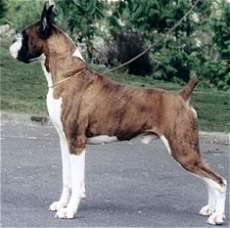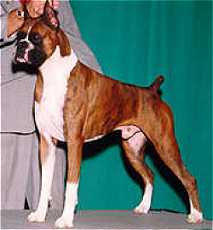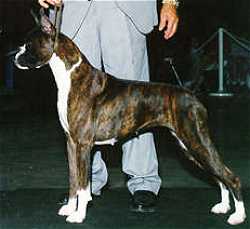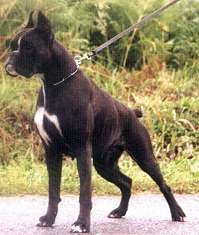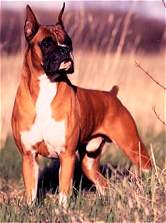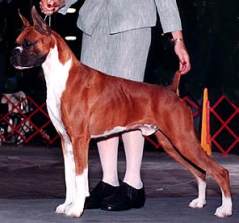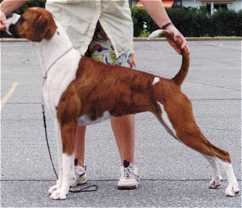
| More Heads | The Body | From the Rear | Movement | Standards | Anatomy | Famous Sires | Photo Gallery | Links |
| Differences Around the World | Body Style Comparisions | Beautiful Heads | Eye Shape | The Skull Shape | Optical Illusions |
| How Structure affects Movement | Choosing a Puppy | Contact Me |
BOXER COLOURS AND MARKINGS
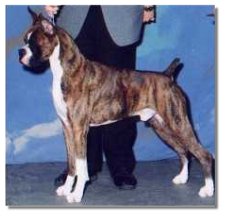 |
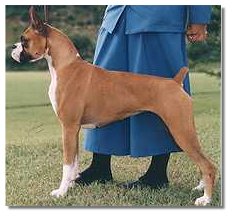 |
Throughout these pages you will see Boxers with differing shades of fawn or brindle coats. All of these colours are permissable for the "Show" Boxer in every country throughout the world.
The FCI Standard states:-
"Fawn or brindle. Fawn colour occurs in varying shades, from pale fawn to dark deer-red, but the most beautiful is in between (red/fawn). Black mask. The brindle variety in the above mentioned shades of fawn has dark or black stripes running in the direction of the ribs. The basic colour and the stripes must clearly contrast. White markings need not be completely rejected, they can be quite appealing.
FAULTS: Mask reaching beyond muzzle. Brindle stripes too close together or only single stripes recognisable. Dirty basic colour. Colours intermingling. Unattractive white markings such as, the whole or one side of the head, white. Other colours or dogs whose is exceeded by more than one third white. "
Golden Brindle Fawn Brindle
The American Standard states:-
"The colors are fawn and brindle. Fawn shades vary from light tan to mahogany. The brindle ranges from sparse but clearly defined black stripes on a fawn background, to such a heavy concentration of black striping that the essential fawn background color barely, although clearly, shows through (which may create the appearance of "reverse brindling").
White markings should be of such distribution as to enhance the dog's appearance, but may not exceed one-third of the entire coat. They are not desirable on the flanks or on the back of the torso proper. On the face, white may replace part of the otherwise essential black mask, and may extend in an upward path between the eyes, but it must not be excessive, so as to detract from true Boxer expression.
FAULTS: Unattractive or misplaced white markings. "
Red Brindle Dark Brindle
The Canadian Standard states:-
"The colours are fawn and brindle. Fawn in various shades from light tan to stag red or mahogany, the deeper colours preferred. The brindle coat in the Boxer is of two opposite types. The first of these includes those dogs having clearly defined dark stripes on a fawn background. The second type has what is best termed reverse brindling. Here the effect is is of a very dark background with lighter coloured fawn stripes or streaks showing through. White markings in fawn or brindle dogs are not to be rejected: in fact, they are often very attractive but must be limited to one-third of the ground colour and are not desirable on the back of the torso proper. On the face, white may replace a part or all of the otherwise essential black mask. However, these white markings should be of such distribution as to enhance and not detract from the true Boxer expression.
DISQUALIFICATIONS: Boxers with white ground colour or entirely white or any colour other than fawn or two types of brindle. White markings that exceed one-third of the ground colour."
Mahogany Brindle "Reverse" Brindle
The English Standard states:-
"Fawn or brindle. White markings acceptable not exceeding one third of ground colour.
Fawn. Various shades from dark red to light fawn.
Brindle. Black stripes on previously described fawn shades, running parallel to ribs all over body. Stripes contrast distinctly to ground colour, neither too close nor too thinly dispersed. Ground colour clear not intermingling with stripes. "
Deep Fawn Dark Deer Red
The Australian Standard states:-
"The permissible colours are fawn, brindle and fawn in various shades from light yellow to dark deer red. The brindle variety should have black stripes on a golden-yellow or red-brown background. The stripes should be clearly defined and above all should not be grey or dirty. Stripes that do not cover the whole top of the body are not desirable. White markings are not undesirable, in fact, they are often very attractive in appearance. The black mask is essential but when white stretches over the muzzle, naturally that portion of the black mask disappears. It is not possible to get black toe-nails with white feet. It is desirable, however, to have an even distribution of head markings. "
FAULTS: Colour: Boxers with white or black ground colour, or entirely white or black or any other colour than fawn or brindle. (White markings are allowed but must not exceed one third (1/3) of the ground colour.)
THE PET BOXER
A pet Boxer can be ANY colour. ALL Boxers including WHITE, CHECK, PARTI-COLOUR, FAWN and BRINDLE, (plain or flashy) make wonderful family pets. The color of a Boxer's coat has nothing to do with the wonderful Boxer personality we all love!!
THE WHITE BOXER
For many years white and check Boxer puppies were culled by most breeders at birth. Their reasoning being that the white colour was always associated with deafness and congenital defects, but although deafness is more common in white Boxers, deafness can also occur in coloured Boxers. Because breeders did not keep or sell their white puppies many people believed that the white Boxer was rare, which is not the case. Actually around 20% of all Boxer puppies born are white, being most common in flashy to flashy breeding, due to the original Boxer ancestors being white.
Although there is a tendency to deafness in all white dogs and cats, deafness can be discovered at a very young age and deaf puppies can be placed in loving, caring homes.
All white and check Boxers are placed on a spay/neuter basis and are not bred.
NB: Extra care must be taken to protect them against sunburn.
White with tan patch
(Check)Mismarked or parti-coloured
(more than 1/3 white)Click here to
SEE HOW COLOUR CAN MAKE A DIFFERENCE
| More Heads | The Body | From the Rear | Movement | Standards | Anatomy | Famous Sires | Photo Gallery | Links |
| Differences Around the World | Body Style Comparisions | Beautiful Heads | Eye Shape | The Skull Shape | Optical Illusions |
| How Structure affects Movement | Choosing a Puppy | Contact Me |
Copyright © Worldwide Boxer - All rights Reserved
Site design by Webpage World

